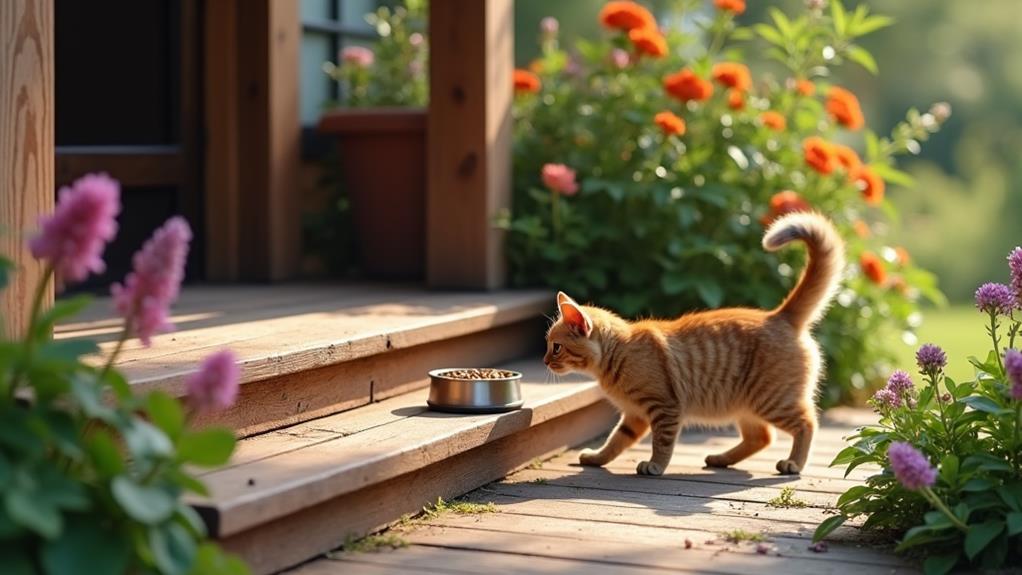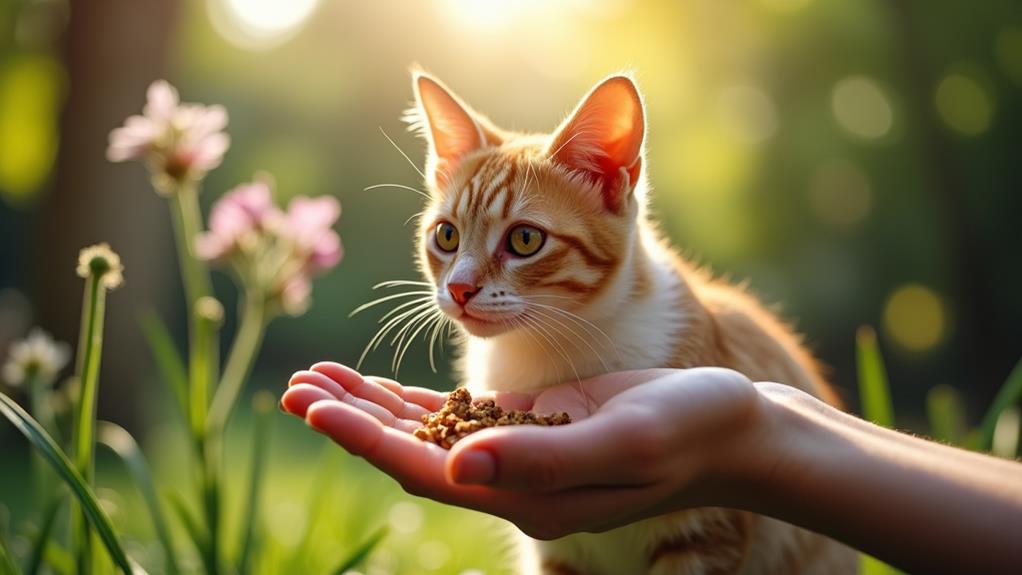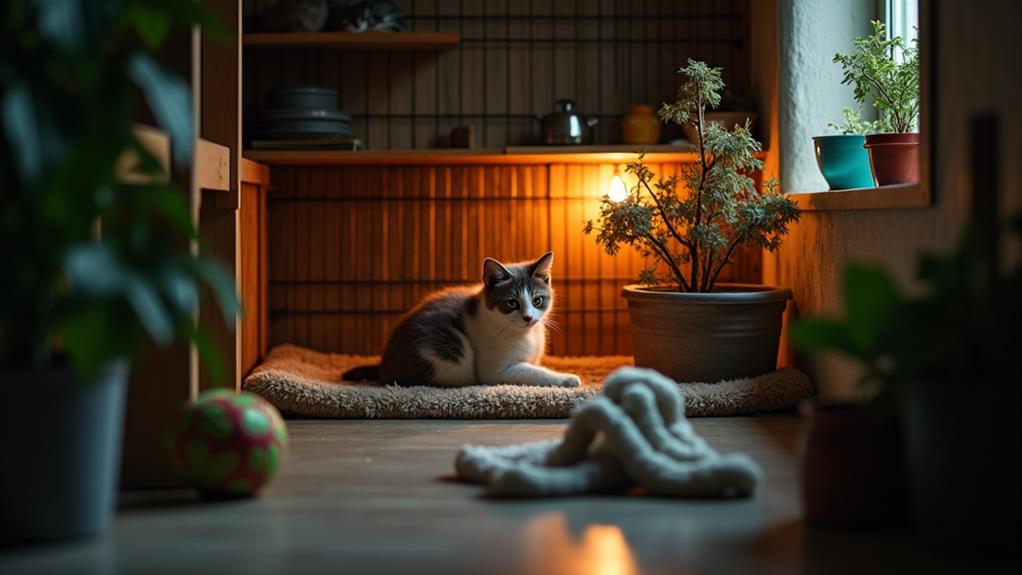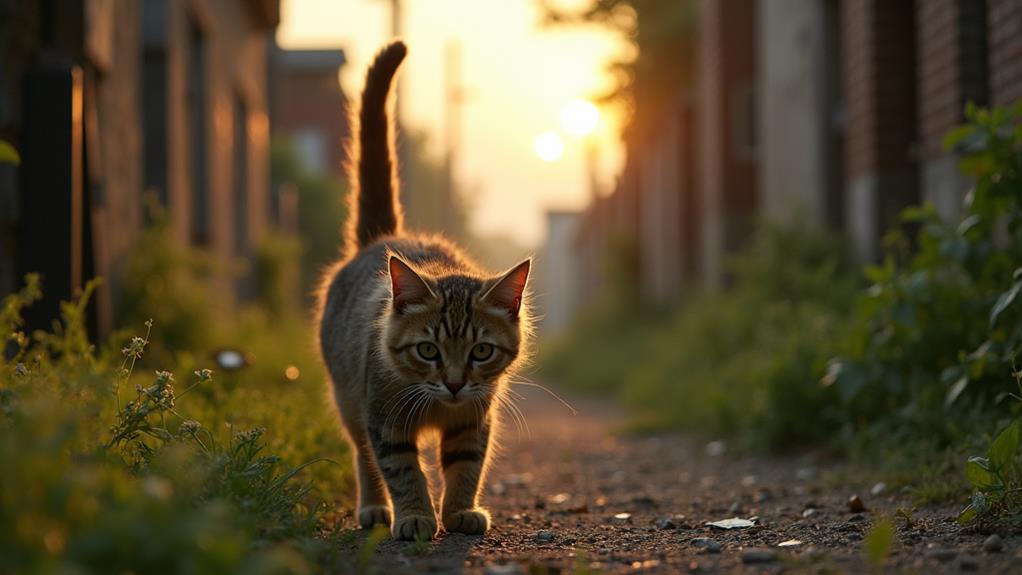How to Befriend a Feral Cat: A Guide to Earning Their Trust

To befriend a feral cat, start by understanding their instinctual fear of humans. Create a safe environment with sheltered spaces and a consistent feeding area. Use strong-smelling foods and establish a routine to earn trust. Gradually sit nearby during feeding times, maintain a calm presence, and avoid direct eye contact. Pay attention to non-verbal cues like tail position and body posture. Offer high-value treats and practice patience, as building trust can take weeks. Consider using calming aids like Feliway or catnip to ease the process. Stick with a routine and guarantee veterinary care for long-term wellbeing and deeper connections. Uncover more strategies on fostering a lasting friendship.
Understanding Feral vs. Stray Cats
Understanding the differences between feral and stray cats is essential to deciding how to approach them. Feral cats are born in the wild and typically shy away from human contact, displaying an instinctual fear and distrust. You'll notice they avoid direct eye contact and tend to keep a low profile. On the other hand, stray cats are often lost or abandoned pets and may actively seek human companionship. They might engage in social behaviors like vocalizing and making eye contact, showing they're more open to interaction.
When it comes to building trust, stray cats can warm up to you over time, especially if you provide consistent food and water. Their past experiences with humans make them more likely to accept human contact. Feral cats, however, require a more cautious approach. Their lack of socialization means they may never fully trust humans. Patience is vital as you gradually earn their trust. Providing food and water consistently can help, but remember, they might always keep a safe distance. Understanding these differences guarantees you can approach each cat with the right strategy, respecting their individual needs and boundaries.
Building a Safe Environment
To successfully befriend a feral cat, creating a safe environment is vital. Start by providing a warm and sheltered space like an insulated cat house or an open garage. This protects the cat from harsh weather and predators, ensuring their comfort and safety. Use straw or blankets to make the bedding area dry and inviting, encouraging the cat to rest there.
Establish a consistent feeding area by placing food and water at the same location and time each day. This routine helps the cat associate the area with nourishment and security, gradually building their trust. It's important to eliminate potential dangers in the environment, such as busy roads and aggressive animals, to further improve their comfort and well-being.
Regularly monitor the cat's behavior to gauge their comfort levels. Adjust the environment as necessary to promote a sense of security. This vigilance demonstrates your commitment to their well-being and strengthens the bond of trust. By thoughtfully setting up a safe, welcoming environment, you'll lay the foundation for a deepening relationship with the feral cat, paving the way for a rewarding companionship.
Effective Feeding Techniques

Feeding feral cats effectively requires a strategic approach that builds their trust over time. Start by using strong-smelling cat food, like canned fish or tuna, which is irresistible to feral cats and will pique their interest during feeding sessions. Establish a consistent feeding schedule by setting out food at the same time each day. This predictability is vital in building familiarity and trust with the cats.
Position the food a safe distance away from yourself initially to avoid startling the feral cat. As they eat, remain calm and still, which will help them feel more comfortable in your presence. Over time, gradually decrease the distance between yourself and the feeding area. This slow approach allows the cat to build trust at their own pace, encouraging them to come closer.
Monitor the food intake to confirm it doesn't attract unwanted wildlife. Furthermore, provide fresh water 2-3 times a day to maintain hygiene and accessibility, which is similarly significant for the cat's wellbeing. By following these feeding techniques, you're not only meeting the cat's nutritional needs but also laying the groundwork for a trusting relationship with these cautious creatures.
Gradual Socialization Strategies
Building a bond with a feral cat starts with patience and gentle persistence. Gradual socialization is key, allowing the cat to approach you at its own pace. Begin by sitting quietly nearby during feeding times. Use a soft, soothing voice to create a calming atmosphere that can help reduce the cat's anxiety about your presence. It's essential not to rush; this process could take days or even weeks.
Initially, avoid direct eye contact, as it might seem threatening to the cat. Instead, pay attention to the cat's body language to gauge its comfort level. If the cat appears relaxed, try offering high-value treats like tuna or wet cat food. These treats can encourage the cat to come closer and associate you with positive experiences.
Make sure your movements are slow and your sounds gentle. Sudden actions might startle the cat, delaying the trust of a stray. Remember, your patience is important. Every small step forward in the cat's comfort with your presence is progress. By respecting the cat's pace and using these strategies, you'll gradually build a foundation of trust, ultimately leading to a lasting bond.
Recognizing Non-Verbal Cues

Understanding a feral cat's body language is vital to building trust. Feral cats use non-verbal cues to communicate their comfort level and intentions. To successfully befriend them, pay attention to these signals:
- Tail Position: A tail held upright or swaying gently indicates a comfortable cat. This is a good sign that the cat feels safe and may be open to interaction.
- Eye Contact: Direct eye contact can be threatening. Instead, try slow blinking to signal you're not a threat. This gesture often helps in easing their defensive behaviors.
- Body Posture: A relaxed posture shows trust, but a low body with flattened ears suggests fear or submission. In such cases, give the cat patience and space to feel more secure.
- Vocalizations and Physical Contact: Purring, kneading, or rubbing against your legs are signs of trust. These actions imply the cat is comfortable and may be ready to engage with you more positively.
Recognizing defensive behaviors, like hissing or growling, is also significant. These indicate the cat feels threatened and needs distance. By understanding and responding appropriately to these cues, you can gradually improve your relationship with feral cats.
Encouraging Positive Interactions
After grasping the nuances of a feral cat's body language, you can start fostering positive interactions. Begin by establishing a consistent feeding schedule with strong-smelling food like tuna or canned fish. This consistency helps the cat form a positive association with your presence, recognizing you as a reliable source of nourishment. Stray cats trust those who provide safety and sustenance.
During feeding times, sit quietly at a distance and avoid sudden movements. This calm approach helps build trust. Gradually decrease the distance between you and the cat, allowing them to approach you at their own pace. This guarantees they don't feel threatened and can safely investigate their comfort zone. Your patience in maintaining this non-intrusive presence is essential in encouraging them to feel more comfortable around you.
Communicate gently using a soft, soothing voice while avoiding direct eye contact. Direct gazes can be intimidating, so looking away signals a non-threatening demeanor, fostering a sense of security for the cat. By following these steps, you create an environment where the cat feels safe and gradually starts to trust you, paving the way for a mutually rewarding relationship.
Patience and Consistency

To successfully befriend a feral cat, patience and consistency are your greatest allies. Building trust with these cautious creatures can take weeks or even months, so it's essential to remain persistent. Your approach should be steady and predictable, particularly concerning feeding. Establish a routine by offering food at the same time and place daily. This creates a sense of familiarity and security, encouraging the cat to feel more comfortable in your presence.
Here's how you can effectively build trust:
- Set a Routine: Always feed the cat at the same times and locations. This consistency helps the cat associate you with safety and reliability.
- Stay Calm: Avoid sudden movements. Move slowly and deliberately during interactions to show you're non-threatening.
- Respect Boundaries: Let the cat approach you on its own terms. Forcing interaction can break trust, so allow it to initiate contact.
- Gradual Proximity: Reduce the distance between you and the cat over time while feeding. This gradual approach promotes a sense of familiarity and comfort.
Utilizing Calming Aids
Why not consider using calming aids to make your interactions with a feral cat smoother? These tools can be incredibly effective in creating a more relaxing environment. Start with Feliway pheromone diffusers, which emit scents mimicking natural feline pheromones. These calming aids can help feral cats feel more at ease, reducing stress and fostering trust-building.
Catnip is another great option. About 50-70% of cats react to it, enjoying a temporary euphoria that might ease initial anxiety. Offer some during your visits to help the cat associate your presence with good feelings. Likewise, Rescue Remedy, a natural flower essence, can be administered to promote calmness, especially when the cat is getting used to a new environment.
When using crucial oils like lavender or chamomile, remember to dilute them properly. Cats are sensitive, so verify these are used sparingly and with caution. Gradually introducing these calming aids and maintaining a consistent routine will increase the cat's comfort and facilitate trust-building over time. By creating a serene atmosphere, you're more likely to win over your feline friend and pave the way for a lasting bond.
Long-Term Care Considerations

Caring for a feral cat over the long term requires a dedicated and thoughtful approach to guarantee their well-being. You need to contemplate several aspects to ensure they thrive in their environment. Here's a concise guide:
- Regular Veterinary Check-Ups: Feral cats will never fully adapt to indoor life, but regular veterinary check-ups are essential. Vaccinations, spaying/neutering, and parasite prevention help keep them healthy and manageable.
- Feeding Routine: Establish a consistent feeding routine. This not only meets their nutritional needs but also allows you to monitor their health. Changes in appetite or weight can signal potential health issues.
- Safe Shelter: Providing a safe shelter is critical. An insulated or heated outdoor shelter can protect them from harsh weather, ensuring they have a secure place to retreat.
- Behavior Observation: Keep an eye on their behavior and body language. Continuous observation helps identify signs of stress, illness, or injury, allowing for timely intervention.
Engaging with local shelters or organizations can offer supplementary support through TNR programs, assisting in population control while promoting the well-being of your feral feline friend. Remember, patience and consistency are key to fostering a trusting relationship.




